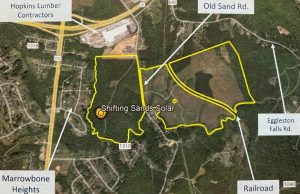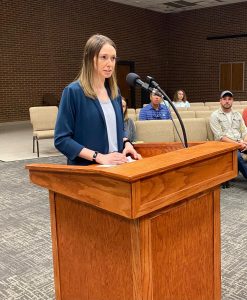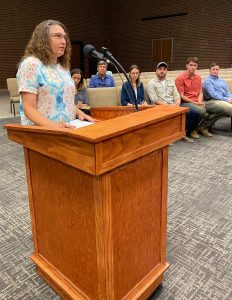The Henry County Board of Zoning Appeals (BZA) unanimously (with one absent) approved a special use permit for a new, large-scale solar farm in Ridgeway at its June 29 meeting.

Shifting Sands Solar, LLC, a subsidiary of Energix, based in Arlington, VA, plans to construct an 18.8-megawatt facility on approximately 268-acres of property located on the east and west side of Old Sand Road, approximately .4-miles south of its intersection with Eggleston Falls Road in the Ridgeway District.
Of the 268-acres, 177 will be used for solar.
Director of Planning, Zoning, and Inspections Lee Clark noted that Shifting Sands included in its proposal plans to retain existing vegetation on the property to create a more robust vegetative buffer, erecting a berm around the property to help with sound deflection and also using sound curtains during construction.
Sound created during the construction phase has been a concern brought up numerous times during public hearings held by the BZA about other solar projects.
Clark said the developers will create conservation easements for the life of the project to protect the surrounding vegetation and buffers.
Following meetings and discussions with residents of neighborhoods near the project, Clark said the developers identified that the Marrowbone Heights neighborhood along the western border of the project would require extra screening because it is the closest residential neighborhood to the development. To that end, Clark said developers proposed 150-feet setbacks and the retaining of 100-feet of existing mature vegetation in that area.

Eliana Ginis, project manager for Shifting Sands, said Energix is one of the leading solar energy companies in Virginia with 8 operational projects, 6 under construction this year, and others in development.
Energix, she said, “is a long-term partner for the communities in which we operate. We site, develop, construct, own, and operate projects through their entire lifecycle, which makes us a reliable partner through every step of the process.”
She added the company sources most of its equipment within the United States.
Ginis said the 91-acres of the property not being used for solar will be used for setbacks, vegetative buffers, pollinator plants, and wetland protection areas.
The 18.8-megawatt capacity of the project, she said, is enough to power approximately 3,000 homes.
“Shifting Sands will deliver economic and tax benefits to Henry County,” she told the board. “With the machinery and tools tax model, Shifting Sands is estimated to contribute approximately $3.3 million over the life of the project.” It will also create about 70 well-paying construction jobs as well as provide a boost to the local hospitality industry because, she said, those who cannot be hired locally will be housed within the county.
At the end of project’s lifespan, which Ginis said could be up to 35-years, the project will be decommissioned, removing all above- and below-ground equipment and seeding the soil with local grass mixes. She noted that, once decommissioned, the area will be suitable for other types of development.
“This is a high-value, non-permanent land use that doesn’t limit the potential future of the land,” she said.
The group hoped to start construction on the project in the second or third quarter of 2023, she said, adding that she anticipated construction would take about 6-months, with the peak activity lasting 3-4 weeks.

Brenda Sessor said she lived in the Marrowbone Heights area just three houses from the wood line that is set to serve as a buffer for the project. She expressed several concerns about the development, including the fate of area wildlife during construction and whether or not they would flee into roadways, how visible the project would be in the fall and winter when the trees lost their leaves, and, primarily, the number of people living in the area who she said did not know about the proposed project.
“I have spoken to at least five other families in my neighborhood that said they did not get door-to-door contact (by the company.) I’ve spoken to several families that said they did not get anything in the mail,” she said.
On her way to the meeting, Sessor said she spoke with another neighbor, asking if he knew about the meeting about the solar farm to which he responded, “what solar farm?”
Clark explained that the Code of Virginia dictated the extent to which his office was required to inform residents of the project.
“I have to advertise it in the newspaper, and I have to notify all the adjoining property owners,” he said. However, he said his office also requires applicants to notify a larger area outside of the adjoining property owners.
“I don’t tell them which people to notify because invariably I’m going to leave somebody out,” he said. “We require them to have the community meeting (which was hosted by the developer at Drewry Mason Elementary School on April 20) … to hopefully get out even more information” to nearby residents.”
Clark said for those who did not receive a newspaper or have internet access, “unfortunately, I have to depend on people like you that take an interest in it to let your neighbors know what’s going on.
“The Marrowbone Heights neighborhood was my number one concern” from the outset of the project, he said. “That’s the very first thing I mentioned to them when the applicants first started talking about this project. It was obvious to me that would be the main (residents) that could be affected” by the solar project.
Ginis said that, though the company initially only went door-to-door and sent information to directly adjoining properties, “when we had the community meeting, we realized there was a big neighborhood that missed out on that information.”
Following that, “I went through the county GIS and got the addresses for every single person in the Marrowbone Heights neighborhood and beyond and sent project information sheets with my phone number and email.”
She added that “because we own the project, we’re not going anywhere. Throughout any stage of the development process or construction, we’re happy to meet with any of the neighbors.
Addressing the concerns about wildlife, she noted that the property had natural wildlife corridors and would maintain existing vegetation so animals would be able to resume their normal migratory patterns upon completion of construction.
Additionally, wildlife fencing would be installed around the project allowing smaller wildlife to move in and out of the property freely.
“Around this project there are streams, and we have setbacks and buffers from the streams” to project wildlife living in and around that area,” she said. “We really take a lot of care to make sure we disrupt as few wildlife as possible on our sites.”
BZA member Paul Setliff noted that any type of construction in the area would be disruptive to animals living there.
Clark noted the portion of the property behind Marrowbone Heights was already zoned for industrial development.
“If we were putting a trucking company there right now instead of a solar farm, we wouldn’t be here today,” he said. “I actually appreciate this use being proposed. This is a much more benign project than what could have been going there.”
Before the vote, Clark commended the developers on the strength and quality of their application.
“I like the history of this company,” Clark said. “Some of the other folks that we’ve dealt with, they don’t tell you that they’re going to be the designers, developers, builders, operators, maintaining it. I have firsthand seen projects in Henry County change hands four times before it ever got constructed. So, for me, it’s a big plus that this company is a one-stop shop. They don’t just build them and flip them.”
The BZA included a number of conditions suggested by Clark in its motion to approve:
First, the site must be maintained in compliance with standards contained in applicable federal, state, and local building codes and erosion and sedimentation control standards and regulations.
Second, existing mature tree growth and natural land forms on the site will be preserved to the maximum extent possible, and conservation easements will be submitted to memorialize that preservation.
Third, any pile driving done during construction can only occur Monday through Saturday, from 8 a.m. until 6 p.m.
Fourth, a double row of evergreen trees must be planted on the interior western boundary of the property to shield the project from view.
Finally, the permit must be exercised within 5-years of approval and must comply with all requirements set forth in the applicable sections of the Zoning Ordinance.




